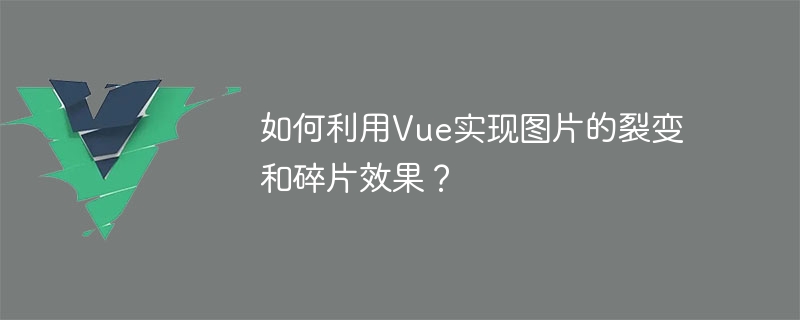如何利用Vue实现图片的裂变和碎片效果?
- WBOYWBOYWBOYWBOYWBOYWBOYWBOYWBOYWBOYWBOYWBOYWBOYWB原创
- 2023-08-25 20:31:491057浏览

如何利用Vue实现图片的裂变和碎片效果?
在前端开发中,经常需要给网页添加一些特效来增强用户体验。其中,图片的裂变和碎片效果是比较常见的特效之一。本文将介绍如何利用Vue框架实现图片的裂变和碎片效果,并附上相关的代码示例。
- 准备工作
首先,你需要准备一张图片作为效果的展示对象。在Vue项目中,可以将图片保存在assets文件夹中,并在组件中引用。assets文件夹中,并在组件中引用。 - 创建Vue组件
接下来,我们需要创建一个Vue组件来实现图片的裂变和碎片效果。在组件的template中,可以使用<img alt="如何利用Vue实现图片的裂变和碎片效果?" >标签来展示图片。同时,为了实现裂变和碎片效果,我们需要在data中定义一些状态值来控制动画效果的展示。
<template>
<div>
<img :src="imageUrl" : style="max-width:90%" alt="" />
<div class="particles" :style="particleStyle" v-if="showParticles"></div>
</div>
</template>
<script>
export default {
data() {
return {
imageUrl: require('@/assets/image.jpg'), // 替换成你的图片地址
imageStyle: {
width: '500px', // 根据图片大小设置宽度
height: 'auto', // 根据图片宽高比计算高度
position: 'relative',
},
particleStyle: {
position: 'absolute',
width: '10px',
height: '10px',
background: 'red', // 碎片的颜色
},
showParticles: false, // 是否展示碎片
}
},
mounted() {
// 设置一个定时器,在3秒后展示碎片效果
setTimeout(() => {
this.showParticles = true;
}, 3000);
},
}
</script>
<style scoped>
.particles {
width: 100%;
height: 100%;
overflow: hidden;
}
</style>- 实现裂变效果
要实现图片的裂变效果,我们可以在mounted钩子中使用canvas来处理图片。具体步骤如下:
- 创建一个
canvas元素,并设置与图片相同的宽高。 - 获取
canvas的上下文并使用drawImage方法将图片绘制到canvas上。 - 使用
getImageData方法获取图片的像素数据,然后对每个像素进行处理。 - 根据像素的位置和颜色,使用
fillRect方法在canvas上绘制一个个小的矩形,形成裂变效果。
以下是裂变效果的代码示例:
<template>
<div>
<canvas ref="canvas" :width="canvasWidth" :height="canvasHeight" />
<div class="particles" :style="particleStyle" v-if="showParticles"></div>
</div>
</template>
<script>
export default {
data() {
return {
imageUrl: require('@/assets/image.jpg'), // 替换成你的图片地址
imageStyle: {
width: '500px', // 根据图片大小设置宽度
height: 'auto', // 根据图片宽高比计算高度
position: 'relative',
},
particleStyle: {
position: 'absolute',
width: '10px',
height: '10px',
background: 'red', // 碎片的颜色
},
canvasWidth: 500,
canvasHeight: 0,
showParticles: false, // 是否展示碎片
}
},
mounted() {
const canvas = this.$refs.canvas;
const ctx = canvas.getContext('2d');
const img = new Image();
img.src = this.imageUrl;
img.onload = () => {
this.canvasHeight = (img.height * this.canvasWidth) / img.width;
canvas.width = this.canvasWidth;
canvas.height = this.canvasHeight;
ctx.drawImage(img, 0, 0, this.canvasWidth, this.canvasHeight);
const imageData = ctx.getImageData(0, 0, this.canvasWidth, this.canvasHeight);
const pixels = imageData.data;
// 对每个像素进行处理
for (let i = 0; i < pixels.length; i += 4) {
const r = pixels[i];
const g = pixels[i + 1];
const b = pixels[i + 2];
const a = pixels[i + 3];
const x = (i / 4) % this.canvasWidth;
const y = Math.floor(i / 4 / this.canvasWidth);
if (Math.random() < 0.5) {
ctx.fillStyle = `rgba(${r},${g},${b},${a / 255})`;
ctx.fillRect(x, y, 1, 1);
}
}
// 定时器,在3秒后展示碎片效果
setTimeout(() => {
this.showParticles = true;
}, 3000);
};
},
}
</script>- 实现碎片效果
要实现图片的碎片效果,我们可以在data中定义一些变量来控制碎片的数量和位置。然后,在mounted钩子中使用v-for创建Vue组件
template中,可以使用<img alt="如何利用Vue实现图片的裂变和碎片效果?" >标签来展示图片。同时,为了实现裂变和碎片效果,我们需要在data中定义一些状态值来控制动画效果的展示。<template>
<div>
<canvas ref="canvas" :width="canvasWidth" :height="canvasHeight" />
<div class="particles" v-if="showParticles">
<div
class="particle"
:class="'particle-' + index"
v-for="(particle, index) in particles"
:key="index"
:style="{ left: particle.x + 'px', top: particle.y + 'px', animationDelay: particle.delay + 'ms' }"
></div>
</div>
</div>
</template>
<script>
export default {
data() {
return {
imageUrl: require('@/assets/image.jpg'), // 替换成你的图片地址
imageStyle: {
width: '500px', // 根据图片大小设置宽度
height: 'auto', // 根据图片宽高比计算高度
position: 'relative',
},
particleStyle: {
position: 'absolute',
width: '10px',
height: '10px',
background: 'red', // 碎片的颜色
},
canvasWidth: 500,
canvasHeight: 0,
showParticles: false, // 是否展示碎片
particles: [], // 碎片数组
}
},
mounted() {
const canvas = this.$refs.canvas;
const ctx = canvas.getContext('2d');
const img = new Image();
img.src = this.imageUrl;
img.onload = () => {
this.canvasHeight = (img.height * this.canvasWidth) / img.width;
canvas.width = this.canvasWidth;
canvas.height = this.canvasHeight;
ctx.drawImage(img, 0, 0, this.canvasWidth, this.canvasHeight);
const imageData = ctx.getImageData(0, 0, this.canvasWidth, this.canvasHeight);
const pixels = imageData.data;
// 对每个像素进行处理
for (let i = 0; i < pixels.length; i += 4) {
const r = pixels[i];
const g = pixels[i + 1];
const b = pixels[i + 2];
const a = pixels[i + 3];
const x = (i / 4) % this.canvasWidth;
const y = Math.floor(i / 4 / this.canvasWidth);
if (Math.random() < 0.5) {
ctx.fillStyle = `rgba(${r},${g},${b},${a / 255})`;
ctx.fillRect(x, y, 1, 1);
}
}
// 初始化碎片数组
for (let i = 0; i < 1000; i++) {
const x = Math.random() * this.canvasWidth;
const y = Math.random() * this.canvasHeight;
const delay = Math.random() * 2000;
this.particles.push({
x,
y,
delay,
});
}
// 定时器,在3秒后展示碎片效果
setTimeout(() => {
this.showParticles = true;
}, 3000);
};
},
}
</script>
<style scoped>
.particles {
width: 100%;
height: 100%;
overflow: hidden;
}
.particle {
position: absolute;
width: 10px;
height: 10px;
background: red; // 碎片的颜色
animation: particle-fade 2s ease-in-out infinite;
}
@keyframes particle-fade {
0% {
opacity: 1;
transform: translateY(0);
}
50% {
opacity: 0;
transform: translateY(20px);
}
100% {
opacity: 1;
transform: translateY(0);
}
}
.particle-0 {
animation-delay: 50ms;
}
.particle-1 {
animation-delay: 100ms;
}
.particle-2 {
animation-delay: 150ms;
}
/* ... */
</style>实现裂变效果
要实现图片的裂变效果,我们可以在mounted钩子中使用canvas来处理图片。具体步骤如下:
- 🎜创建一个
canvas元素,并设置与图片相同的宽高。🎜🎜获取canvas的上下文并使用drawImage方法将图片绘制到canvas上。🎜🎜使用getImageData方法获取图片的像素数据,然后对每个像素进行处理。🎜🎜根据像素的位置和颜色,使用fillRect方法在canvas上绘制一个个小的矩形,形成裂变效果。🎜- 🎜实现碎片效果🎜要实现图片的碎片效果,我们可以在
data中定义一些变量来控制碎片的数量和位置。然后,在mounted钩子中使用v-for循环生成碎片,并设置它们的位置和动画效果。🎜🎜🎜以下是碎片效果的代码示例:🎜rrreee🎜通过上述代码示例,我们可以在Vue中轻松实现图片的裂变和碎片效果。当页面加载后,图片会先裂变成碎片,然后经过一段时间的动画效果后,最终展示出完整的图片。你可以根据实际需求调整代码中的参数,来达到你想要的效果。🎜🎜希望本文能对你理解Vue中图片裂变和碎片效果的实现有所帮助!🎜以上是如何利用Vue实现图片的裂变和碎片效果?的详细内容。更多信息请关注PHP中文网其他相关文章!
声明:
本文内容由网友自发贡献,版权归原作者所有,本站不承担相应法律责任。如您发现有涉嫌抄袭侵权的内容,请联系admin@php.cn

